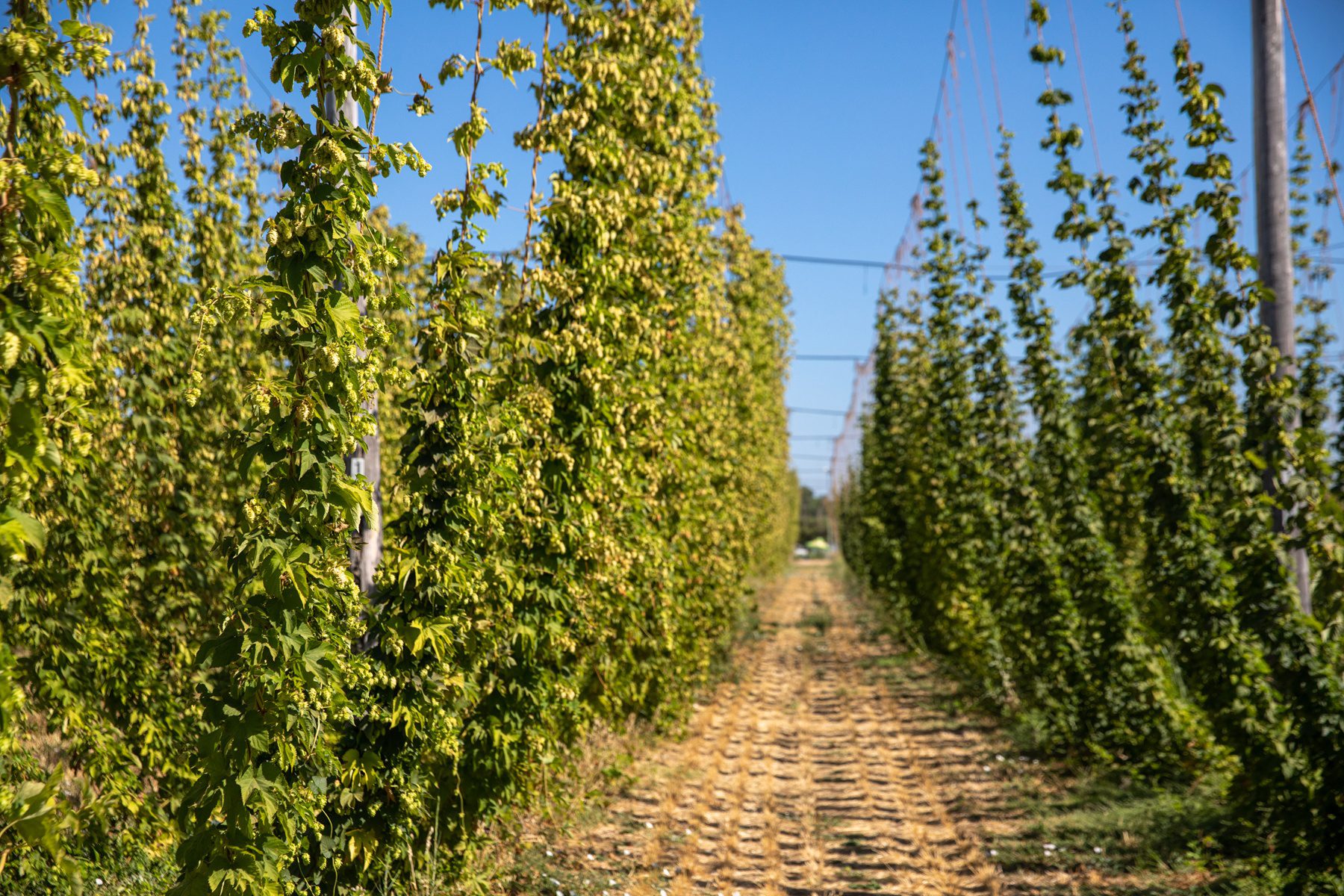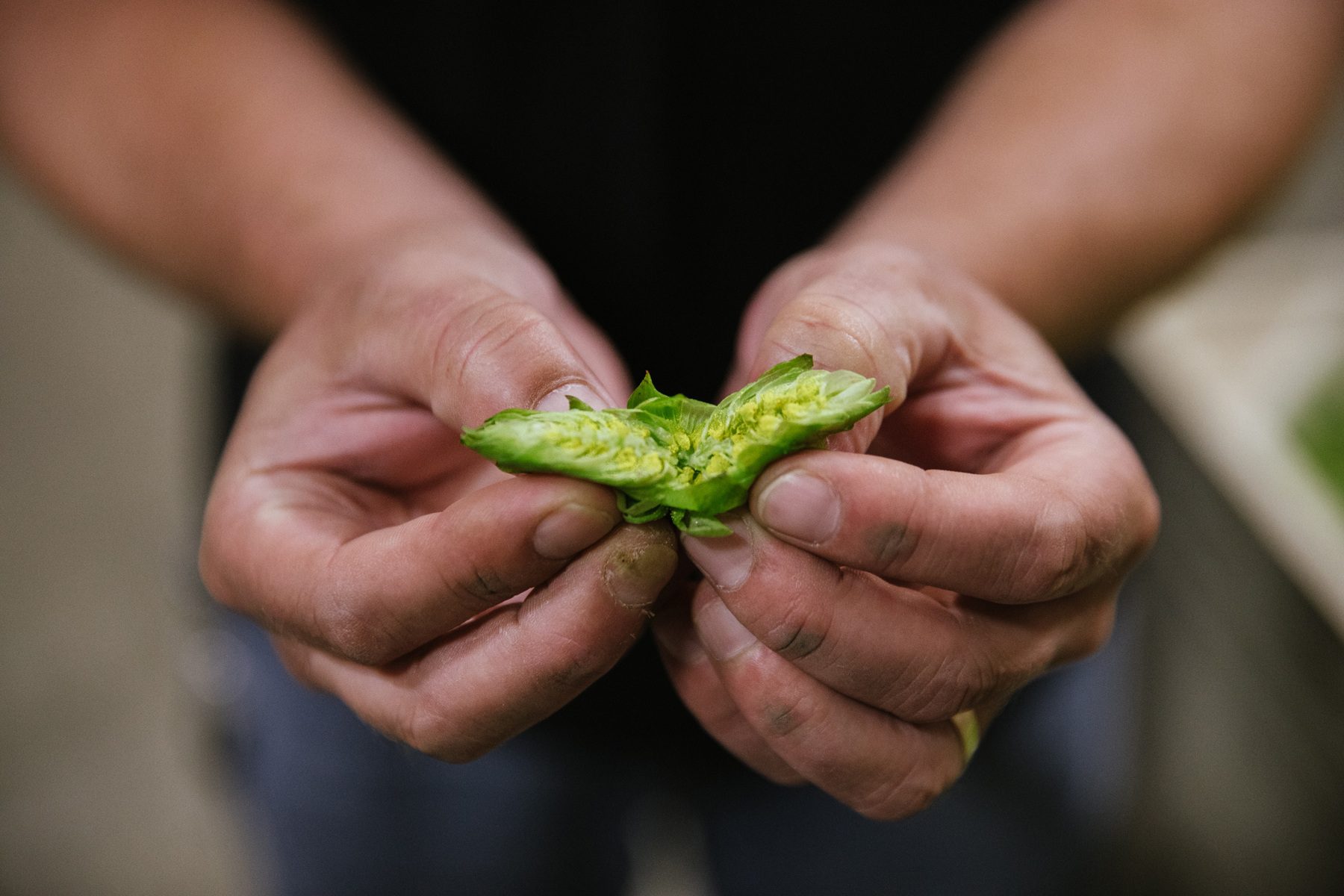The flavor of freshly picked produce is unmatched: a peach from the tree, a carrot from the ground, a blueberry from the bush. It follows that hops, the flowers of a perennial plant that climbs sky-high, exhibit their peak aroma and flavor right when they’re harvested.
Most hops are processed and packaged so craft brewers can store them for great lengths of time. After all, when you’re making beer year-round, brewers always need hops at the ready. But once a year, right at the cusp of fall, you’ll often see limited-time releases of wet hop beers and fresh hop beers. Why should you try them, and why do they make brewers so giddy?

What are Wet Hops and Fresh Hops?
The definitions of wet hops and fresh hops are not universal. Plenty of craft brewers use the terms interchangeably to identify hops that are picked and totally unprocessed — just plump green cones, right from the field.
At Sierra Nevada we talk about them as two camps. We describe wet hops as those that get harvested, are not dried, and rushed home for immediate brewing. In the case of our Northern Hemisphere Harvest Wet Hop IPA, it’s a 24-hour window from when the hops come down to when they hit our brew kettle — in essence a “same day” IPA. Northern Hemisphere debuted in 1996 and inspired a wave of wet hop beers in the decades since.

We specify fresh hops as those that do get kiln-dried and pressed into 200-pound bales, but time is again the key: we use them within a few weeks. Celebration Fresh Hop IPA is a trailblazer for fresh hop beer, having grown into a seasonal favorite since its 1981 introduction.

The Freshness Factor: Wet Hops vs. Dried Hops
Whether it’s wet hops (undried) or fresh hops (dried and used fast), the goal is to impart beers with hop character at its most intense. And it’s all about the lupulin inside of hops, those tiny yellow glands, packed with resins and oils, that are delicious triple threats of bitterness, aroma, and flavor.

When hops go through the kiln-drying process, they of course lose moisture, but there’s some loss of precious oil too. Then with the passage of time, like any agricultural product, the potency of hops naturally declines. Hence the thrill of brewing and drinking beers made specially during hop harvest, the pinnacle of aroma and flavor.

Brewing with the Seasons: Hop Harvest Ales
When we reference hop harvest, by default we mean North America, in the Pacific Northwest, and right as summer shifts to fall. Oregon, Idaho, and Washington are the top hop-producing states, and we travel there every year to hand-select the best hops for the months ahead. (We even make a separate trip dedicated to hop selection for Celebration Fresh Hop IPA.)
But Southern Hemisphere hops, whose harvest starts around March, have also found the spotlight in American craft brewing. We’ve used varieties like Galaxy, Nectaron, and Motueka toward a number of small-batch, online-only beers. And we’ve got all the fond memories for Southern Hemisphere Harvest IPA, last made in 2021, brewed with New Zealand hops flown straight to the brewery days after growers picked them.
And while hops are best grown at scale in moderate climates, we overcome the blazing summer sun here in Chico, Calif., to maintain 2.5 acres of our own certified-organic Estate hops. They combine with our homegrown organic barley toward seasonal beers like Estate Ale. (And when we have other excess Estate crops, you might find something like Estate Melon Gose on the Taproom menu.)

Planning for Wet Hop Brewing
Perhaps the main challenge of brewing with wet hops is the sheer volume you need to achieve a recipe’s aroma and flavor goals. Unlike hops that have been kiln-dried, wet hops have high moisture content — around 80% of their total weight. So in the case of Northern Hemisphere Wet Hop IPA, we use about four times as many wet hops, by weight, versus what we’d need if they were kiln-dried.
Just compare the photos below: wet hops stored loose in large bins versus kiln-dried hops that are pressed like hay bales. Those bales are jam packed!


A Symphony of Senses: Aroma and Flavor Profiles in Wet Hopped Beers
You can cook tasty meals with dried herbs from the store. But walking through your home garden, picking living herbs, and adding them real-time to your dish is something special. That’s the magic of wet hop and fresh hop beers.

Wet hops and fresh hops, when considering a single variety, share plenty of aroma and flavor characteristics. But wet hops can boast extra nuances like bright “green” or grassy notes, fruit zest, or floral aromas. Northern Hemisphere IPA, which for the past few years has featured exclusively wet Centennial hops, has distinct notes of rose alongside its vibrant pine.
ORDER NORTHERN HEMISPHERE IPA
Available in late September, while supplies last

Celebration IPA, a fresh hop beer, uses Cascade and Centennial hops raced from farm to brewery for citrus, pine, and floral flavors at their most powerful, all balanced by malty sweetness. It’s become an icon over four decades, the IPA that signals Let the holidays begin.
FIND CELEBRATION IPA
Available October–December
Wet Hop Innovation: Hop Harvest, Anytime
It’s only natural to long for wet hopped beer when it’s out of season. Well rejoice! Our Cool Little Thing IPA uses Cryo Fresh™ hops, an innovation that makes harvest flavor possible, anytime.

Cryo Fresh hops start with whole cones, picked from the field and put straight into a patented cryogenic process that separates the hop leaves from the lupulin inside. Stored at subzero temperatures, it’s hop harvest frozen in time.
Cool Little Thing launched in June 2024, and it will be gone before the new year, so don’t miss out. Crystal, Comet, and El Dorado hops join Cryo Fresh Mosaic for aromas and flavors that span citrus, mango, and the punchy “green” of hop harvest.
Get A Taste of Harvest While You Can
Brewers and beer drinkers cherish the annual hop harvest, when those fleeting wet hop and fresh hop beers emerge to showcase aroma and flavor at their zenith. Whether they’re brewed with undried hops (wet) or kiln-dried hops (fresh), speed is paramount: brewing ASAP before any hop intensity fades.
Harvest beers are here and gone, so savor the moment. Try Northern Hemisphere IPA, the wet hop beer that launched them all, and the fresh hop legend Celebration IPA — ready for all the holiday gatherings ahead.




